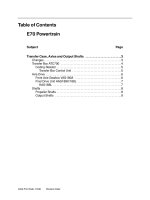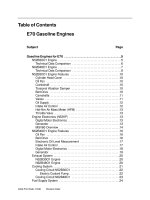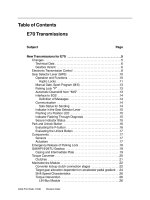C1527 02
Bạn đang xem bản rút gọn của tài liệu. Xem và tải ngay bản đầy đủ của tài liệu tại đây (20.37 KB, 2 trang )
Designation: C 1527 – 02
Standard Specification for
Travertine Dimension Stone1
This standard is issued under the fixed designation C 1527; the number immediately following the designation indicates the year of
original adoption or, in the case of revision, the year of last revision. A number in parentheses indicates the year of last reapproval. A
superscript epsilon (e) indicates an editorial change since the last revision or reapproval.
TABLE 1 Physical Requirements
1. Scope
1.1 This specification covers the material characteristics,
physical requirements, and sampling appropriate to the selection of travertine for general building and structural purposes.
1.2 Dimension travertine shall include stone that is sawed,
cut, split, or otherwise finished or shaped and shall specifically
exclude molded, cast, or otherwise artificially aggregated units
composed of fragments, and also crushed and broken stone.
Physical
Property
Test
ClassifiRequirements cations
Absorption by weight, max, %
2.5
2.5
144 (2305)
Density, min, lb/ft (kg/m )
144 (2305)
Compressive strength, min, psi (MPa) 7500 (52)
5000 (34.5)
Modulus of rupture, min, psi (MPa)
1000 (6.9)
700 (4.8)
10
Abrasion resistance, min, HaA,B,C
10
Flexural strength, min, psi (MPa)
1000 (6.9)
700 (4.8)
3
2. Referenced Documents
2.1 ASTM Standards:
C 97 Test Methods for Absorption and Bulk Specific Gravity of Dimension Stone2
C 99 Test Method for Modulus of Rupture of Dimension
Stone2
C 119 Terminology Relating to Dimension Stone2
C 170 Test Method for Compressive Strength of Dimension
Stone2
C 241 Test Method for Abrasion Resistance of Stone Subjected to Foot Traffic2
C 880 Test Method for Flexural Strength of Dimension
Stone2
C 1353 Test Method for Abrasion Resistance of Stone
Subjected to Foot Traffic by the Taber Abrader Method2
3
I Exterior
II Interior
I Exterior
II Interior
I Exterior
II Interior
I Exterior
II Interior
I Exterior
II Interior
I Exterior
II Interior
Test
Methods
C 97
C 97
C 170
C 99
C 241/C 1353
C 880
A
Pertains to foot traffic only. Where two or more stone varieties are combined
for color and design effects, there should be no greater difference than five points
in abrasion resistance.
B
The supplier of the No. 60 Alundum abrasive, Norton, has indicated that the
formula for Norton treatment 138S has been changed. The new abrasive is
currently more aggressive, resulting in lower abrasion resistance values (Ha) than
when the standard was initially established. As such, care should be taken when
interpreting Ha values from tests using the new abrasive, particularly with regard to
current ASTM stone standard specification requirements for abrasion resistance,
which were developed when the original abrasive was still in use.
C
It is not necessary to perform both tests. Availability of the proper equipment
and materials by the testing laboratory may determine which test is performed.
4.3 Voids in travertine are a natural characteristic of the
material and shall be considered in assessing the permissible
natural variations suitable for a particular application.
4.3.1 Some travertines may not be suitable for exterior use
in areas subject to frequent freeze-thaw cycles.
4.3.2 Travertine that is fleuri-cut (cross-cut) rather than
vein-cut can be expected to experience certain problems,
because some areas of the exposed surface will consist of only
a thin layer of stone that covers a void in the stone.
4.4 The desired color and texture, with their permissible
natural variations in material characteristics for material to be
produced for the project, shall be established by control
samples. Representative samples shall be selected prior to
production by viewing a sufficient number of samples that
show the complete range of variations in color and texture of
the travertine specified.
3. Terminology
3.1 Definitions—All definitions are in accordance with Terminology C 119.
3.1.1 fleuri-cut (cross-cut), adj—describes stone that is cut
parallel to the natural veining.
3.1.2 vein-cut, adj—describes stone that is cut perpendicular to the natural veining.
4. Physical Properties
4.1 Travertine supplied under this specification shall conform to the physical requirements prescribed in Table 1.
4.2 Travertine shall be free of minerals that may cause
objectionable staining under normal environments of use.
5. Sampling
5.1 Samples, if required, for testing to determine the characteristics and physical properties shall be representative of the
travertine to be used.
1
This specification is under the jurisdiction of ASTM Committee C18 on
Dimension Stone and is the direct responsibility of Subcommittee C18.03 on
Material Specifications.
Current edition approved May 10, 2002. Published July 2002.
2
Annual Book of ASTM Standards, Vol 04.07.
Copyright © ASTM International, 100 Barr Harbor Drive, PO Box C700, West Conshohocken, PA 19428-2959, United States.
1
C 1527
ASTM International takes no position respecting the validity of any patent rights asserted in connection with any item mentioned
in this standard. Users of this standard are expressly advised that determination of the validity of any such patent rights, and the risk
of infringement of such rights, are entirely their own responsibility.
This standard is subject to revision at any time by the responsible technical committee and must be reviewed every five years and
if not revised, either reapproved or withdrawn. Your comments are invited either for revision of this standard or for additional standards
and should be addressed to ASTM International Headquarters. Your comments will receive careful consideration at a meeting of the
responsible technical committee, which you may attend. If you feel that your comments have not received a fair hearing you should
make your views known to the ASTM Committee on Standards, at the address shown below.
This standard is copyrighted by ASTM International, 100 Barr Harbor Drive, PO Box C700, West Conshohocken, PA 19428-2959,
United States. Individual reprints (single or multiple copies) of this standard may be obtained by contacting ASTM at the above
address or at 610-832-9585 (phone), 610-832-9555 (fax), or (e-mail); or through the ASTM website
(www.astm.org).
2









